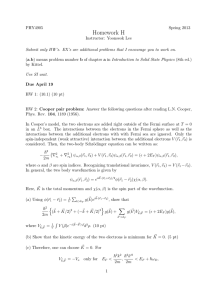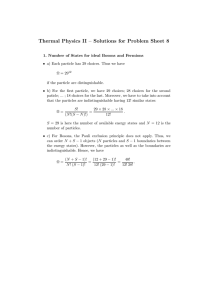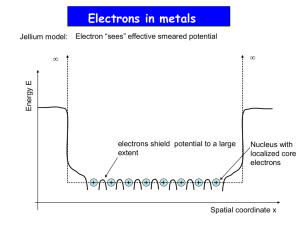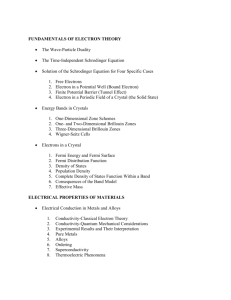Document 13554944
advertisement
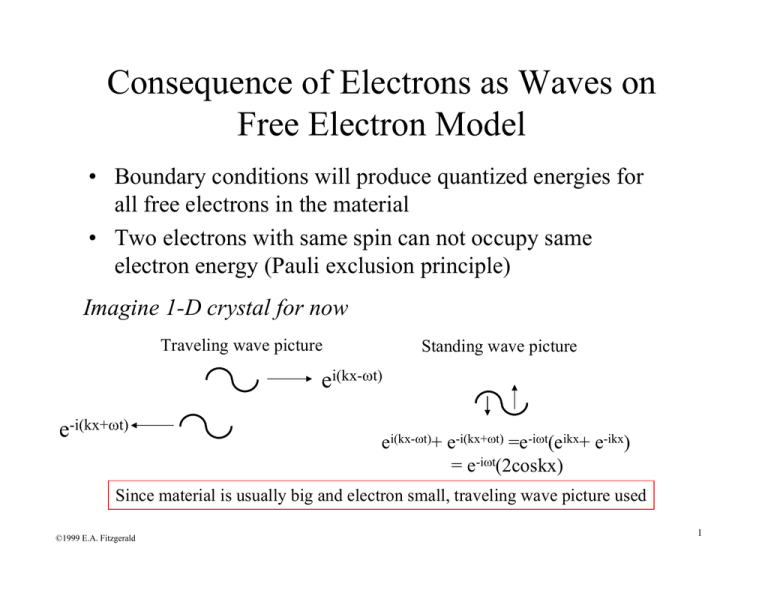
Consequence of Electrons as Waves on Free Electron Model • Boundary conditions will produce quantized energies for all free electrons in the material • Two electrons with same spin can not occupy same electron energy (Pauli exclusion principle) Imagine 1-D crystal for now Traveling wave picture Standing wave picture ei(kx-ωt) e-i(kx+ωt) ei(kx-ωt)+ e-i(kx+ωt) =e-iωt(eikx+ e-ikx) = e-iωt(2coskx) Since material is usually big and electron small, traveling wave picture used ©1999 E.A. Fitzgerald 1 Consequence of Electrons as Waves on Free Electron Model Traveling wave picture 0 L Standing wave picture Ψ(x) = Ψ(x + L) 0 L e ikx = e ik ( x+ L) 1 = e ikL k= 2πn L Just having a boundary condition means that k and E are quasi-continuous, i.e. for large L, they appear continuous but are discrete ©1999 E.A. Fitzgerald 2 Representation of E,k for 1-D Material h 2k 2 p 2 = E= 2m 2m states electrons E All e- in box accounted for EF m=+1/2,-1/2 En+1 En En-1 Quasi-continuous dE h 2 k = dk m h 2k ΔE = Δk m Δk=2π/L kF kF Total number of electrons=N=2*2kF*L/2π ©1999 E.A. Fitzgerald k 3 Representation of E,k for 1-D Material N= h2k 2 2mE ;k = E= 2m h 2 dE h k = dk m 2k F L π 1 dN dk 1 2 m 2m − 2 g(E) = = = E dk dE L π h 2 k πh g(E)=density of states=number of electrons per energy per length n= nπ N 2k F 2 2mE F or k F = = = π 2 hπ L •n=is the number of electrons per unit length, and is determined by the crystal structure and valence •The electron density, n, determines the energy and velocity of the highest occupied electron state at T=0 ©1999 E.A. Fitzgerald 4 Representation of E,k for 2-D Material E= h 2 (k x2 + k y2 ) E(kx,ky) 2m ky kx ©1999 E.A. Fitzgerald 5 Representation of E,k for 3-D Material kz ky Ε(kx,ky,kz) E= kF m π2 ( 2mE h 3 1 3 hk vF = F m ©1999 E.A. Fitzgerald Fermi Surface or Fermi Sphere ) k F = 3π 2 n 2m kx 2π/L g(E) = h 2 (k x2 + k y2 + k z2 ) h 2 k F2 EF = 2m TF = EF kB 6 So how have material properties changed? • The Fermi velocity is much higher than kT even at T=0! Pauli Exclusion raises the energy of the electrons since only 2 e- allowed in each level • Only electrons near Fermi surface can interact, i.e. absorb energy and contribute to properties TF~104K (Troom~102K), EF~100Eclass, vF2~100vclass2 Element rs /ao Li Na K Rb Cs Cu Ag Au Be Mg Ca Sr Ba Nb Fe Mn Zn Cd Hg Al Ga In Tl Sn Pb Bi Sb 3.25 3.93 4.86 5.20 5.62 2.67 3.02 3.01 1.87 2.66 3.27 3.57 3.71 3.07 2.12 2.14 2.30 2.59 2.65 2.07 2.19 2.41 2.48 2.22 2.30 2.25 2.14 εF 4.74 eV 3.24 2.12 1.85 1.59 7.00 5.49 5.53 14.3 7.08 4.69 3.93 3.64 5.32 11.1 10.9 9.47 7.47 7.13 11.7 10.4 8.63 8.15 10.2 9.47 9.90 10.9 TF 5.51 x 104 K 3.77 2.46 2.15 1.84 8.16 6.38 6.42 16.6 8.23 5.44 4.57 4.23 6.18 13.0 12.7 11.0 8.68 8.29 13.6 12.1 10.0 9.46 11.8 11.0 11.5 12.7 νF kF 1.12 x 108 cm-1 0.92 0.75 0.70 0.65 1.36 1.20 1.21 1.94 1.36 1.11 1.02 0.98 1.18 1.71 1.70 1.58 1.40 1.37 1.75 1.66 1.51 1.46 1.64 1.58 1.61 1.70 1.29 x 108 cm/sec 1.07 0.86 0.81 0.75 1.57 1.39 1.40 2.25 1.58 1.28 1.18 1.13 1.37 1.98 1.96 1.83 1.62 1.58 2.03 1.92 1.74 1.69 1.90 1.83 1.87 1.96 Fermi energies, fermi temperatures, fermi waves vectors, and fermi velocities for representative metals* * The table entries are calculated from the values of rs / a0 given in Table 1.1 using m = 9.11 x 10-28 grams. Table by MIT OpenCourseWare. ©1999 E.A. Fitzgerald 7 Effect of Temperature (T>0): Coupled electronic-thermal properties in conductors (i.e. cv) • Electrons at the Fermi surface are able to increase energy: responsible for properties • Fermi-Dirac distribution • NOT Bolltzmann distribution, in which any number of particles can occupy each energy state/level Originates from: EF ...N possible configurations T=0 T>0 1 f = e ©1999 E.A. Fitzgerald If E-EF/kbT is large (i.e. far from EF) than ( E −E F ) k bT +1 f =e −( E −E F ) k bT 8 Fermi-Dirac Distribution: the Fermi Surface when T>0 f(E) fBoltz 1 kbT kbT T=0 T>0 0.5 All these e- not perturbed by T Boltzmann-like tail, for the larger E-EF values μ~EF E Heat capacity of metal (which is ~ heat capacity of free e- in a metal): ⎛ ∂U ⎞ cv = ⎜ ⎟ ⎝ ∂T ⎠ v U ~ ΔE ⋅ ΔN ~ kbT ⋅ [g (E F ) ⋅ kbT ] ~ g (E F ) ⋅ (kbT ) 2 ⎛ ∂U ⎞ 2 cv = ⎜ ⎟ = 2 ⋅ g(EF ) ⋅ kb T ⎝ ∂T ⎠ v ©1999 E.A. Fitzgerald U=total energy of electrons in system Right dependence, very close to exact derivation 9 Heat Capacity (cv) of electrons in Metal • Rough derivation shows cv~const. x T , thereby giving correct dependence • New heat capacity is about 100 times less than the classical expectation Exact derivation: cvclass cvquant ©1999 E.A. Fitzgerald cv = π2 3 ⋅ kb2T ⋅ g (EF ) 3 nkb 3 E 2 = 2 F ~ 100@ RT = 2 π kbT π ⎛ kbT ⎞ ⎟⎟nkb ⎜⎜ 2 ⎝ EF ⎠ 10

